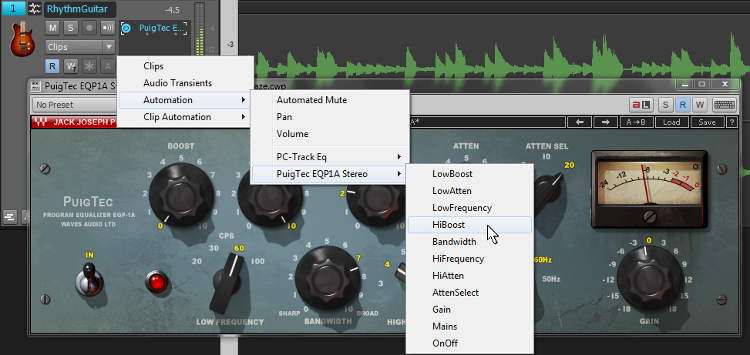Can’t get a guitar to sit right in the mix? Equalization is your friend
When you’re mixing guitar, you want it to play well with other tracks. These tips can help achieve that goal.
ATTENUATE THE LOW FREQUENCIES
Every instrument should stake its own claim in the frequency spectrum. For example, bass and kick own the low end; if the guitar has lots of low end, the bass and kick will mask the guitar sound, and the guitar’s low-frequency energy will “blur” the kick and bass. There’s an easy fix: Add a low cut filter. Many plug-in EQs have steep slopes, like 48 dB/octave; cut mercilessly below 100 Hz or so. The bass and kick will acquire more clarity, and the guitar sound will tighten.
TWEAK EQ IN CONTEXT WITH OTHER INSTRUMENTS
Anyone (well, almost anyone!) can solo a guitar and make it sound good—with warm lows, sizzling highs, and a beefy midrange. But bring in the other instruments, and like the example above with bass and kick, the guitar will become less distinct because the frequency ranges of other instruments will mask the guitar. You need to be selective in where you cut and boost, based on what the other instruments are doing.
USE EQ TO INCREASE ARTICULATION
The ear is very sensitive in the 3-4 kHz range, so you can make any instrument stand out in the mix by boosting in this range. In the featured screen shot, the EQ setting (using the Waves PuigTec EQP1A) attenuates the low frequencies, and adds a slight boost at 4 kHz for extra definition. Careful, though; too much upper midrange boost can make the sound harsh, strident, and fatiguing. A little goes a long way.
KEEP EQ COMPLEMENTARY
Consider guitar, piano, and voice—all of which overlap in several ranges. To make the voice stand out, boost the highs somewhat (e.g., a high-frequency shelving filter boost starting around 2 kHz) so it rides above the more “midrangey” piano and guitar. Now decide whether the guitar or piano will own the lower midrange, and let the other instrument own the upper midrange—for example, cut the piano a bit at 500 Hz and boost around 1.5 kHz to emphasize the upper mids, while boosting guitar around 400 Hz and cutting at around 1-2 kHz to emphasize the lower mids. Now the three instruments will sit in their own distinct ranges.
PANNING COMES LAST
Separating instruments by panning is the easy way out—in the example above, piano left, guitar right, voice center—problem solved, right? No. While they don’t overlap spatially, their frequencies still do. If you can EQ instruments into their own space when mixed in mono, when you create a stereo spread they’ll be even more distinct.
AUTOMATION LOVES EQ
EQ needn’t be “set and forget.” If the guitar needs to be mixed more prominently in particular places, don’t just increase the level. Think of EQ as a frequency-selective volume control; find frequencies where the other instruments aren’t represented, and boost the guitar in only those ranges. The guitar will become more prominent, but without “smearing” the other instruments. In the featured image above, the EQ is being set up in Cakewalk by BandLab for automated control over the amount of 4 kHz boost, so the guitar can sound a little brighter in some parts, and duller in others.
MORE GUITAR IS NOT ALWAYS BETTER GUITAR
Layering can help smooth out a guitar so it sits back more in the mix, but for maximum prominence, a single mono guitar track can be the best choice.
